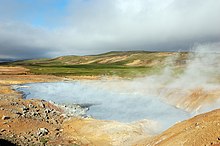Geothermal area

A geothermal area (also thermal area ) is an area with hot springs , geysers , fumaroles or solfataras , where increased geothermal heat is given off in the form of water or water vapor .
A common subdivision is made according to the (water) temperature at a depth of 1000 meters: If this is more than 150 ° C, then one speaks of a high-temperature area, if it is lower, it is a low-temperature area. The water temperatures are often well above the aboveground boiling point, which is shifted due to the rock pressure.
High temperature area
A high temperature area is located above particularly hot and therefore active magma herds of a volcano or volcanic system. At 1000 m depth, the water temperature is between 250 and 300 ° C.
High temperature areas are everywhere on earth where there is volcanic activity. Here are some examples:
- USA: Yellowstone National Park with Norris Geyser Basin and Mammoth Hot Springs
- New Zealand: Wai-O-Tapu and Whakarewarewa
- Chile: El Tatio
- Ethiopia: Dallol
- Italy: Larderello
In Iceland there are more than 20 major high-temperature areas, all located in the volcanically active zone which extends diagonally across the island. These include, for example, Torfajökull , Krafla , several on the Hengill and a few more on the Reykjanes Peninsula .
Low temperature area
In the case of a low-temperature area, it is assumed that the magma center below has now cooled down somewhat. The water temperature at a depth of 1000 m is 150 ° C or less.
Examples of low-temperature areas in Iceland are the Reykholtsdalur with the Deildartunguhver or some areas on the Snæfellsnes peninsula.
See also
literature
- Ari Trausti Guðmundsson: Living Earth. Facets of the geology of Iceland . Mál og Menning, Reykjavík 2007, ISBN 978-9979-3-2778-3 , pp. 329-359
- Steve McNutt, Haraldur Sigurdsson and Hazel Rymer: Encyclopedia of Volcanoes . Academic Press, 1999, ISBN 978-0-1264-3140-7 , pp. 835-855
Web links
- USGS: Geothermal Activity (English)
- Summary of the geothermal areas in Iceland (PDF; 187 kB)
